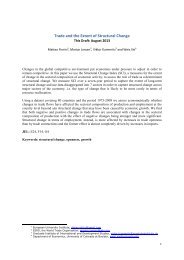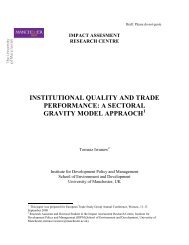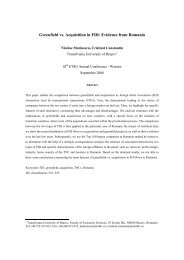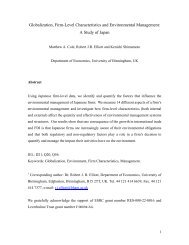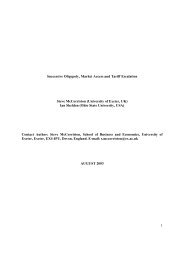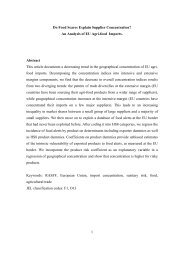Regional integration and the other determinants of North-South ...
Regional integration and the other determinants of North-South ...
Regional integration and the other determinants of North-South ...
Create successful ePaper yourself
Turn your PDF publications into a flip-book with our unique Google optimized e-Paper software.
increase in firm localisation. As it becomes less costly to export within <strong>the</strong> integrated region,<br />
firms can <strong>the</strong>n have a greater incentive to concentrate <strong>the</strong>ir production in <strong>the</strong> country with<br />
lower production costs. In addition, when countries belong to several PTAs, <strong>the</strong>y can<br />
constitute a hub <strong>and</strong> export to all spokes at a low tariff (Chen, 2008). Following this idea,<br />
Altomonte (2007) shows <strong>the</strong> importance <strong>of</strong> promoting <strong>integration</strong> between all countries<br />
belonging to <strong>the</strong> area <strong>and</strong> not only between small countries <strong>and</strong> <strong>the</strong> largest market.<br />
Because <strong>of</strong> <strong>the</strong> importance <strong>of</strong> trade costs in economic geography, a growing literature<br />
is aimed at measuring <strong>and</strong> underst<strong>and</strong>ing <strong>the</strong>m. Within <strong>the</strong> euro-Mediterranean area, trade<br />
barriers between countries may be significant (especially between <strong>South</strong>/<strong>South</strong> countries).<br />
They may be <strong>the</strong> result <strong>of</strong> physical transport costs, political dissension or imperfect trade<br />
<strong>integration</strong> 34 . However, high quality data on direct measures <strong>of</strong> policy barriers are poor <strong>and</strong><br />
incomplete especially with regard to non-tariff barriers to trade. Given <strong>the</strong>se problems,<br />
following many authors, we use an indirect measure <strong>of</strong> market access based on <strong>the</strong> <strong>the</strong>ory <strong>of</strong><br />
gravity. The border effect approach, initiated by McCallum (1995), has been recently<br />
completed by <strong>the</strong>oretical foundations (Deardorff (2001), Anderson <strong>and</strong> van Wincoop, (2003)).<br />
This approach permits us to account for <strong>the</strong> fact that internal dem<strong>and</strong> is largely met by<br />
domestic producers (Mayer <strong>and</strong> Zignago, 2005) 35 . In addition, <strong>the</strong> border effect approach<br />
captures all <strong>the</strong> trade impediments related to <strong>the</strong> existence <strong>of</strong> national borders 36 . Following<br />
this recent literature, we propose to infer <strong>the</strong> trade costs in <strong>the</strong> euro-Mediterranean area from<br />
an economic model linking trade flows to observable variables <strong>and</strong> unobservable trade costs.<br />
As Head <strong>and</strong> Mayer (2004), Chen (2004) <strong>and</strong> Altomonte (2007), we use information from<br />
international trade flows to calculate a proxy for transport costs. Redding <strong>and</strong> Venables<br />
(2004) <strong>and</strong> Head <strong>and</strong> Mayer (2004) show that <strong>the</strong> dem<strong>and</strong> function (equ. 3.6) can be<br />
reinterpreted as <strong>the</strong> volume <strong>of</strong> sales per firm in each location. Expressing <strong>the</strong>se in aggregate<br />
value gives exports from c to l:<br />
(4.2)<br />
ln ln ln ln (4.3)<br />
Bilateral trade flows ( depend on <strong>the</strong> importers’ “capacity market” <br />
which reflect <strong>the</strong> countries’ masses <strong>and</strong> consumers price indexes. Bilateral trade flows are<br />
also related to <strong>the</strong> product <strong>of</strong> <strong>the</strong> number <strong>of</strong> firms <strong>and</strong> <strong>the</strong>ir price competitiveness .<br />
The countries’ masses can be proxied by countries’ GDPs ( <strong>and</strong> . Price<br />
indexes capture <strong>the</strong> magnitude <strong>of</strong> average trade barriers faced by <strong>the</strong> country l. Both price<br />
indexes <strong>and</strong> price competitiveness are related to <strong>the</strong> unobserved country-specific<br />
heterogeneity, <strong>the</strong> so-called “multilateral resistance” (Anderson <strong>and</strong> van Wincoop, 2003).<br />
Following Head <strong>and</strong> Mayer (2004) <strong>and</strong> Altomonte (2007), we have included country fixed-<br />
34<br />
Even if <strong>the</strong> <strong>integration</strong> is incomplete in <strong>the</strong> period studied, countries already have trade relations with each<br />
o<strong>the</strong>rs.<br />
35<br />
The border effect methodology consists in comparing <strong>the</strong> relative volumes <strong>of</strong> intra <strong>and</strong> international trade for<br />
two countries.<br />
36<br />
By using a bilateral trade equation derived from a <strong>the</strong>oretical model, some authors show how taking <strong>the</strong> <strong>the</strong>ory<br />
seriously can provide a much more useful interpretation (Anderson <strong>and</strong> van Wincoop, 2003, Head <strong>and</strong> Mayer,<br />
2004).<br />
13



